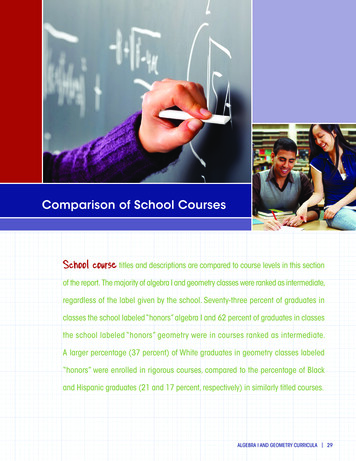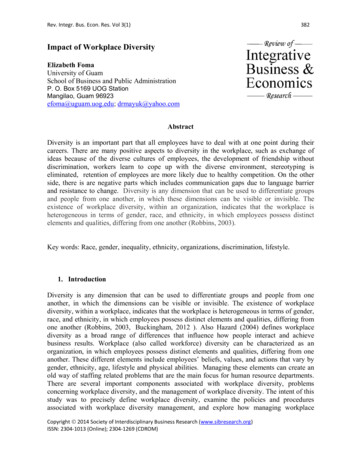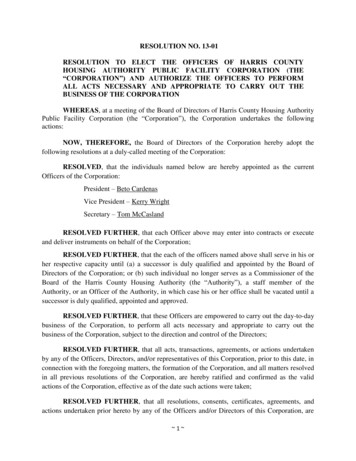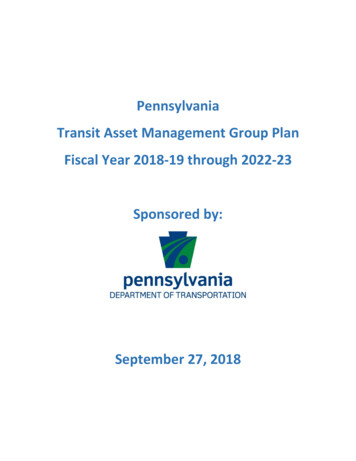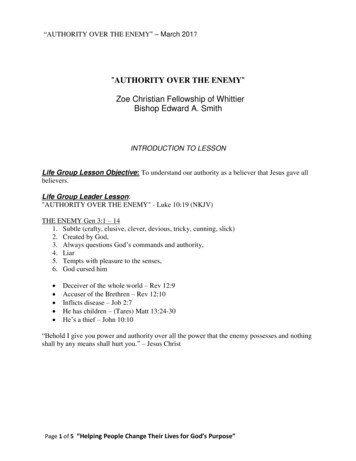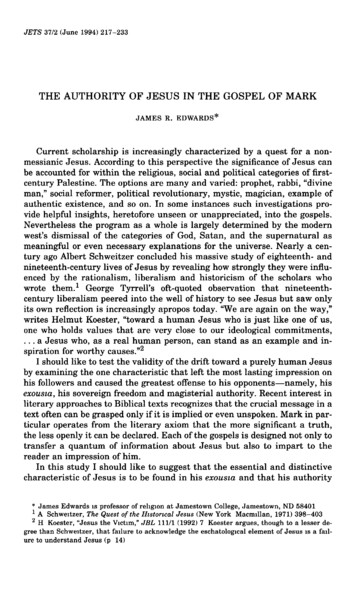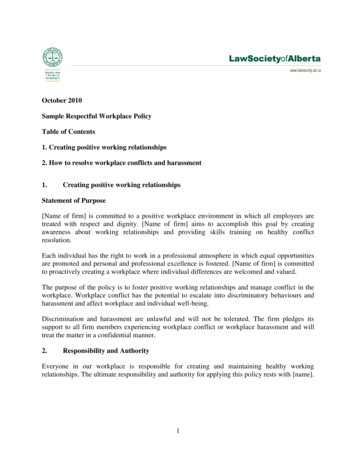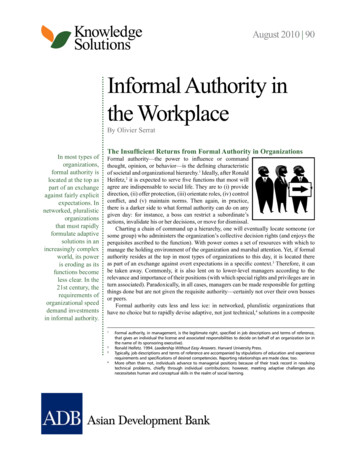
Transcription
KnowledgeSolutionsAugust 2010 90Informal Authority inthe WorkplaceBy Olivier SerratIn most types oforganizations,formal authority islocated at the top aspart of an exchangeagainst fairly explicitexpectations. Innetworked, pluralisticorganizationsthat must rapidlyformulate adaptivesolutions in anincreasingly complexworld, its poweris eroding as itsfunctions becomeless clear. In the21st century, therequirements oforganizational speeddemand investmentsin informal authority.The Insufficient Returns from Formal Authority in OrganizationsFormal authority—the power to influence or commandthought, opinion, or behavior—is the defining characteristicof societal and organizational hierarchy.1 Ideally, after RonaldHeifetz,2 it is expected to serve five functions that most willagree are indispensable to social life. They are to (i) providedirection, (ii) offer protection, (iii) orientate roles, (iv) controlconflict, and (v) maintain norms. Then again, in practice,there is a darker side to what formal authority can do on anygiven day: for instance, a boss can restrict a subordinate’sactions, invalidate his or her decisions, or move for dismissal.Charting a chain of command up a hierarchy, one will eventually locate someone (orsome group) who administers the organization’s collective decision rights (and enjoys theperquisites ascribed to the function). With power comes a set of resources with which tomanage the holding environment of the organization and marshal attention. Yet, if formalauthority resides at the top in most types of organizations to this day, it is located thereas part of an exchange against overt expectations in a specific context.3 Therefore, it canbe taken away. Commonly, it is also lent on to lower-level managers according to therelevance and importance of their positions (with which special rights and privileges are inturn associated). Paradoxically, in all cases, managers can be made responsible for gettingthings done but are not given the requisite authority—certainly not over their own bossesor peers.Formal authority cuts less and less ice: in networked, pluralistic organizations thathave no choice but to rapidly devise adaptive, not just technical,4 solutions in a compositeFormal authority, in management, is the legitimate right, specified in job descriptions and terms of reference,that gives an individual the license and associated responsibilities to decide on behalf of an organization (or inthe name of its sponsoring executive).2Ronald Heifetz. 1994. Leadership Without Easy Answers. Harvard University Press.3Typically, job descriptions and terms of reference are accompanied by stipulations of education and experiencerequirements and specifications of desired competencies. Reporting relationships are made clear, too.4More often than not, individuals advance to managerial positions because of their track record in resolvingtechnical problems, chiefly through individual contributions; however, meeting adaptive challenges alsonecessitates human and conceptual skills in the realm of social learning.1
KnowledgeSolutionsworld, the power of formal authority is eroding as its utilitybecomes less clear. (As a result, many managers often feel I would rather try to persuade a man to gothey have traded their erstwhile, relative freedom against a along, because once I have persuaded him,chimera.) At the same time, since many organizations are he will stick. If I scare him, he will stay just asdiscarding command-and-control hierarchies in favor of long as he is scared, and then he is gone.flatter management structures, and essential expertise and—Dwight Eisenhowerdecision-making ability is ever more widely dispersed inorganizations,5 it is necessary to excel at persuasion to move people in the right direction and get work donethrough others under new conditions. Therefore, all things considered, formal authority is best understood as thepotential for power, the total amount of which 21st century organizations should aim to expand by leveragingmutual influence among personnel.Table 1: The Myth and Reality of Formal AuthorityMythRealityOperative PrincipleAuthorityInterdependencySource of PowerFormal authority“Everything but ”Key PlayersSubordinatesIncludes those outside one’s formalauthorityDesired OutcomesComplianceNeed for identification andinternalizationManagerial CompetenciesPrimarily technicalTechnical, human, conceptualSource: Adapted from Linda Hill. 2000. What It Really Means to Manage: Exercising Power and Influence. Harvard Business School Note No.400–041. Harvard Business School.The Challenge of New-Age LeadershipLeadership is a process of social influence by which a person enlists the aid and support of others in accomplishinga common task. Having a positive leadership effect does not depend on formal authority; indeed, some ofthe best leadership comes from people who purposely eschew that. Conversely, many persons in positions ofauthority do not exercise leadership: to (endeavor to) fulfill the five basic social functions enumerated above,they navigate warily between Charybdis and Scylla, keenCharacter may almost be called the mostto avoid the troubles that arise when one asks people toeffective means of persuasion.confront problems; they are quite happy to simply preserve—Aristotle equilibrium. Extreme responses are to become overlydirective or too collaborative.Education levels have risen and information and communication technology make more knowledge accessible to many more than in thepast. Moreover, creativity and innovation are now seen as central to organizational performance: management cannot be expected to betheir sole source but must certainly manage for them.52
Informal Authority in the WorkplaceTable 2: Use and Abuse of Directive and Collaborative LeadershipDirectiveToo DirectiveCollaborativeToo CollaborativeLeads personally. Ispersonally involved insolving his or her unit’sproblems.Takes over. Does not givepeople enough rope.Enables subordinates tolead. Is able to let go andgive individuals the samelatitude to do their jobs.Empowers to a fault. Givespeople too much rope.Lets people know clearlyand with feeling where heor she stands on issues.Declares himself or herself.Other people do not speakout, are not heard.Is interested in where otherpeople stand on issues. Isreceptive to their ideas.People do not know wherehe or she stands.Makes difficult callsincluding those withadverse effects on people.Is insensitive, callous.Is compassionate. Isresponsive to people’sneeds and feelings.Is overly accommodating.Is nice to people at expenseof work.Makes judgments. Zerosin on what is substandardor is not working in anindividual’s or unit’sperformance.Is harshly judgmental.Dismisses the contributionsof others. Is an unlovingcritic.Shows appreciation. Makesother people feel goodabout their contributions.Helps people feel valued.Gives false praise or praisesindiscriminately. Is anuncritical fan.Is competitive. Is highlymotivated to excel and havehis or her unit excel.Is parochial, a partisan.Creates rivalries.Is a team player. Helpsother units or the largerorganization perform well.Sacrifices sharp focus onown unit. Does not arguefor legitimate interests.Has an intense can-doattitude. Expects everyoneto do whatever it takes toget the job done.Pushes too hard. Demandsthe impossible. Risksburnout.Is realistic about limitson people’s capacity toperform or produce.Is too understanding. Doesnot expect enough.Is confident. Gives peoplethe feeling that he or shebelieves in self and his orher abilities.Is arrogant. Fails torecognize or acknowledgeothers’ talents.Is modest. Is aware thathe or she does not knoweverything and can bewrong.Is self-effacing or downon self. Is too quick todiscount own views.Is persistent. Stays thecourse even in the face ofadversity.Sticks rigidly to a courseof action, even in the faceof strong evidence it is notworking.Is flexible. Is willingto change course if theplan does not seem to beworking.Is inconstant, changeable.Is too quick to changecourse.Raises tough issues. Insistson working through toconclusion.Forces issues when finessewould work better.Fosters harmony. Containsconflict. Defuses tension.Avoids or smoothes overtense issues that needattention.Source: Adapted from Robert Kaplan. 1999. The Dimensions of Forceful and Enabling Leadership: Virtues and Vices. Leadership in Action.Vol. 19, No. 4.Clearly then, there is a difference between what returns can be expected from formal authority on one sideand from leadership on the other: hence, clarion calls for more informal authority in organizations. Unlikethe former, which relies on conformity without acceptance,6 the power of informal authority to influenceattitudes and behaviors rests on admiration, credibility, respect, and trust, which conduce conformity coupledwith acceptance. Notions of distributed leadership and management by persuasion appeal: by their means,Herbert Kelman. 1958. Compliance, Identification, and Internalization: Three Processes of Attitude Change. Journal of Conflict Resolution.Vol. 2, No. 1, pp. 51–60.63
KnowledgeSolutionsorganizations can become sophisticated and versatile, listening to and utilizing the expertise of many to intensifymutual influence and make vision real and central.Defining InfluenceThe record of mankind’s attempts to define (then refine) the principles of successful social influence is long.7In the sphere of interpersonal relationships, influence is having a vision of the optimum outcome for events orcircumstances and then motivating people to work together to make the vision authentic.Herbert Kelman has identified three broad varieties of social influence—namely, compliance, identification,and internalization—that represent three qualitatively different ways of accepting influence. Paraphrasing,compliance takes place when an individual accepts influence because he or she hopes to achieve a favorablereaction from another person or group. That is, theindividual adopts the induced attitude or behavior because I don’t know the rules of grammar. If you’rehe or she expects to gain specific rewards or approval and trying to persuade people to do something, oravoid specific punishments or disapproval by conforming. buy something, it seems to me you should useIdentification occurs when an individual accepts influence their language.because he or she wants to establish or maintain a satisfying—David Ogilvyself-defining relationship with another person or group. Heor she adopts the induced behavior or attitude because it is associated with the desired relationship. Internalizationhappens when an individual accepts influence because the contents of the induced behavior or attitude—theideas and actions that compose it—are intrinsically rewarding. He or she adopts it because of congruence withhis or her value system. From a social psychology perspective, the determinants of conformity are normative8and informational.9Enter the Law of ReciprocityIn truth, irrespective of whether authority is formal or informal, the force that drives attitudes and behaviors,and therefore influence, is the near-universal belief that people should (in one form or another) be paid back forwhat they do, be that good or bad. Individuals and groups will respond to one another in similar ways: they willreact to kindnesses and gifts with benevolence; conversely, they will respond to hurtful acts with some form ofretaliation (or at least indifference). Their methods can be crude and mechanical, such as a literal executions ofthe principle of “an eye for an eye” (“tit for tat”); or they can be complex and sophisticated, e.g., one-to-one,one-to-many, many-to-one, and generalized reciprocity. (Parallels exist in the animal world.)Connection promotes collaborative intent and multiplies the chances of collaboration. Usefully, AllanCohen and David Bradford10 have framed an influence model based on reciprocity;11 it brings the metaphorof currencies into play to describe the process of influence as exchange. They contend that effective managersattempt to build collaborative arrangements with potential allies, even when the latter seem at first adversaries,by discerning what currencies they might have to offer. (Sources of currencies are, broadly, organizationally,job-, and personally determined.) In other words, a manager will exercise influence only in so far as he or shecan offer something that others value. (The model need not be restricted to management; it applies to otherwalks of life, too.)At least five types of currencies are at work in various organizational settings: (i) inspiration-related, (ii)Aristotle’s Rhetoric dates from the 4th century BC. It gives a working definition of rhetoric, namely, the ability, in each particular case, tosee the available means of persuasion; investigates the three means of persuasion that an orator must draw on, that is, ethos, logos, andpathos; and introduces the elements of style (word choice, metaphor, and sentence structure) and arrangement (organization).8Normative social influence happens when one conforms to be liked or accepted by the members of a group.9Informational social influence takes place when one turns to the members of a group to obtain and accept information as evidence aboutreality.10Allan Cohen and David Bradford. 2005. The Influence Model: Using Reciprocity and Exchange to Get What You Need. Journal ofOrganizational Excellence. Vol. 25, No. 1, pp. pages 57–80.11Robert Cialdini lists reciprocity—people repay in kind—as one of six principles of (ethical) persuasion. The others he cites are (i) consistency—people align with their clear commitments, (ii) social proof—people follow the lead of similar others, (iii) liking—people like those who likethem, (iv) authority—people defer to experts, and (v) scarcity—people want more of what they can have less of. See Robert Cialdini. 1984.Influence: The Psychology of Persuasion. William Morrow and Company, Inc.74
Informal Authority in the WorkplaceFigure: The Cohen-Bradford Model of Influence Without AuthorityIdentify relevantcurrencies, theirs,yours.Diagnose theworld of theother person.Influence throughgive and take.Managerelationships.Assume all arepotential allies.Clarify yourgoals andpriorities.Source: Adapted from Allan Cohen and David Bradford. 2005. The Influence Model: UsingReciprocity and Exchange to Get What You Need. Journal of Organizational Excellence. Vol. 25,No. 1, pp. pages 57–80.task-related, (iii) position-related, (iv) relationship-related, and (v) person-related.12 Many require no permissionto spend, e.g., expressing gratitude, showing appreciation, paying respect, making the attainments of othersvisible, enhancing someone else’s reputation, and extending one’s personal help on tasks.13 Unsurprisingly,the use of each is context-specific and hinges on the availability of capital. However, almost everyone hasa portfolio of currencies, and even though some are more highly valued than others, trade-offs are oftenpossible—granting that some people may have such fundamental differences in what they hold dear that jointunderstanding is on occasion difficult to reach:14 the keyis to identify one’s resources relative to a potential ally’s“I” cannot reach fulfillment without “thou.”wants without underestimating what one has to offer.The self cannot be self without other selves.The Cohen–Bradford model of influence rests on aSelf-concern without other-concern is likelong-established feature of human nature as it relates toa tributary that has no outward flow to theorganizational context. (The recent breakthroughs of socialocean.neuroscience are fostering other comprehensive theories—Martin Luther King of the mechanisms that underlie human behavior.) Atboth individual and organizational levels, also in the caseof formal authority, and enriched or not by Robert Cialdini’s five other principles of persuasion, the modelilluminates the necessary practice of persuading in the workplace. It does well to expose the fallacies ofgratuitous guidelines for mastering the art of persuasion and the pseudo-scientific injunctions of persuasionOne can also, by the same token, identify negative currencies. These come in two forms: (i) withholding payment of a known valuablecurrency, and (ii) using directly undesirable currencies. Common examples of the former include not giving recognition, not offeringsupport, not providing challenge, and threatening to quit a particular situation. Directly undesirable currencies include raising one’s voice,shouting, refusing to cooperate when asked, escalating issues to a common supervisor, going public with a contentious issue, making lackof cooperation visible, and attacking a person’s reputation or integrity.13We are, sages say, better defined by what we share than by what we own.14This is more likely where societal cultural values and individual social beliefs conflict.125
KnowledgeSolutionscampaigns.15Table 3: Currencies Frequently Used in OrganizationsCurrencyPurchasing PowerInspiration-RelatedVisionExcellenceMoral and Ethical CorrectnessBeing involved in a task that has larger significant for the unit, office, division, ororganization; clients, audiences, and partners; or society at largeHaving the opportunity to do important things very wellDoing what is right by a "higher" standard than efficiencyTask-RelatedNew ResourcesChallenge and LearningAssistanceOrganizational SupportRapid ResponseInformationObtaining money, budget increases, personnel, space, etc.Being able to carry out tasks that strengthen skills and abilitiesReceiving help with existing projects or unwanted tasksReceiving overt or subtle backing or direct assistance with implementationGetting something more quicklyObtaining access to organizational or technical tation"Insiderness" and ImportanceContactsAcknowledgment of effort, accomplishment, or abilitiesThe chance to be known by higher-ups or significant others in the organizationBeing seen as competent, committedA sense of centrality, of belongingOpportunities to link with othersRelationship-RelatedAcceptance and InclusionUnderstandingPersonal SupportFeeling closeness and friendshipHaving concerns and issues listened toReceiving personal and emotional backingPerson-RelatedGratitudeOwnership and InvolvementSelf-conceptComfortAppreciation, expression of indebtednessOwnership of and influence over important tasksAffirmation of values, self-esteem, and identityAvoidance of hasslesSource: Adapted from Allan Cohen and David Bradford. 2005. The Influence Model: Using Reciprocity and Exchange to Get What You Need.Journal of Organizational Excellence. Vol. 25, No. 1, pp. pages 57–80.Further ReadingADB. 2009a. Understanding and Developing Emotional Intelligence. Manila. Available: e.pdf―――. 2009b. Building Trust in the Workplace. Manila. Available: ons/building-trust-in-the-workplace.pdf―――. 2009c. Leading in the Workplace. Manila. Available: ns/leading-in-the-workplace.pdf―――. 2009d. Servant Leadership. Manila. Available: ns/exercising-servant-leadership.pdf―――. 2009e. Distributing Leadership. Manila. Available: ns/distributing-leadership.pdfAn example of the former typically runs as follows: (i) connect emotionally, (ii) find the common ground, (iii) establish your credibility,and (iv) become an effective team builder. In the phases of change management campaigns, the persuasion process would typically askchange agents to (i) convince personnel that radical change is imperative and demonstrate why a new direction is the right one; (ii) positionand frame the preliminary plan, gather feedback, and announce the final plan; (iii) manage the mood of personnel through constantcommunication; and (iv) reinforce behavioral guidelines to avoid backsliding.156
Informal Authority in the Workplace―――. 2009f. A Primer on Social Neuroscience. Manila. Available: ons/primer-on-social-neuroscience.pdfAllan Cohen and David Bradford. 1989. Influence Without Authority. John Wiley & Sons, Inc.For further informationContact Olivier Serrat, Head of the Knowledge Management Center, Regional and Sustainable Development Department,Asian Development Bank (oserrat@adb.org).Asian Development BankADB’s vision is an Asia and Pacific region free of poverty. Its mission isto help its developing member countries reduce poverty and improvethe quality of life of their people. Despite the region’s many successes, itremains home to two thirds of the world’s poor: 1.8 billion people wholive on less than 2 a day, with 903 million struggling on less than 1.25a day. ADB is committed to reducing poverty through inclusive economicgrowth, environmentally sustainable growth, and regional integration.Based in Manila, ADB is owned by 67 members, including 48 from theregion. Its main instruments for helping its developing member countriesare policy dialogue, loans, equity investments, guarantees, grants, andtechnical assistance.Knowledge Solutions are handy, quick reference guides to tools,methods, and approaches that propel development forward and enhanceits effects. They are offered as resources to ADB staff. They may alsoappeal to the development community and people having interest inknowledge and learning.The views expressed in this publication are those of the author(s) and donot necessarily reflect the views and policies of the Asian DevelopmentBank (ADB) or its Board of Governors or the governments they represent.ADB encourages printing or copying information exclusively for personaland noncommercial use with proper acknowledgment of ADB. Users arerestricted from reselling, redistributing, or creating derivative works forcommercial purposes without the express, written consent of ADB.Asian Development Bank6 ADB Avenue, Mandaluyong City1550 Metro Manila, PhilippinesTel 63 2 632 4444Fax 63 2 636 s7
Table 1: The Myth and Reality of Formal Authority Myth Reality Operative Principle Authority Interdependency Source of Power Formal authority "Everything but " Key Players Subordinates Includes those outside one's formal authority Desired Outcomes Compliance Need for identification and internalization


